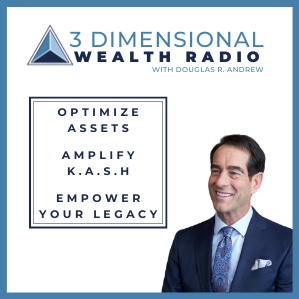Can you become a millionaire by putting away $500 a month? Yes, it’s possible, especially with a financial vehicle like a properly structured, maximum-funded Indexed Universal Life policy.
But even more important, it’s not necessarily what you begin with that counts, it’s what you end up with.
I’ve been helping people plan for their financial future since the 70s, so I can tell you that the game changed when Indexed Universal Life came out in 1997. As people prepare for long-term goals such as retirement, business growth, real estate management, college funding for kids, etc., I’m an advocate for a properly structured, maximum-funded Indexed Universal Life policy, or what I call a LASER Fund.
The LASER Fund can provide critical advantages, including:
- Liquidity – The ability to access your money when you need it, without penalties or income tax
- Safety – Insurance companies are historically among the safest institutions for your money; and with IUL policies, your principal is safely protected by a 0% floor during market downturns.
- Predictable Rates of Return – While there are few guarantees when it comes to rates of return, ideally you want a LASER Fund’s historically predictable rates of return, as well as that 0% floor to protect you when the markets head south.
- Tax Advantages – Uncle Sam can take a serious toll on your financial future, so The LASER Fund’s ability to access your money income-tax-free and pass it along to your heirs income-tax-free can make a huge difference.
ONLY FOR THE AFFLUENT?
Now often when we give examples of max-funded IUL policies, like we do in Section I, Chapter 9 of my book, “The LASER Fund”, we use examples of policies with a Guideline Single Premium of $500,000, fully funded in as few as five years.
That leaves some to wonder if LASER Funds are for those with that kind of money on hand.
The answer is, no, this is not just a vehicle for the affluent. It’s something that’s attainable for many who are striving for a brighter financial future. So this then begs the question:
What is the minimum amount you can invest in a LASER Fund?
To get to that answer, it’s helpful to consider:
- What’s the least amount that you could put in on an average monthly basis?
- What’s the grand total you want to put in?
The answer to that first question is based on your disposable income now, and what you anticipate it to be in the future. When my wife, Sharee, and I were young, our answer to that question was just about $25 a month, per policy.
You see, over the years, we opened policies on each of our six children, contributing just $25 a month to each policy’s Guideline Single Premium, occasionally adding larger chunks of money when we could. In time, those policies grew to be worth hundreds of thousands of dollars.
The second question above is helpful in steering your Guideline Single Premium, or how much you want to be allowed to put into the policy over the first four to 11 years. Let’s say you want to set that GSP at $100,000. You and your IUL specialist will then structure your policy around that $100,000 GSP.
Now, once your policy is in place, are you required to put in all of that $100,000? No. That’s simply the MOST you could put in over the first about four to 11 years.
Once you reach $100,000, you’re done. Keep in mind with LASER Funds, there’s only a limit to how much you can PUT IN. The exciting thing is, there’s no limit to how much your policy’s accumulation value CAN GROW. It can grow to millions and millions of dollars tax-free.
WHAT ABOUT $500 A MONTH?
I would say right now, if you can set aside $500 a month in today’s dollars ($6,000 a year), you could get started with your own LASER Fund. While you’re in the process of fully funding your policy, you can put in more than that during any given month, or you can put in less. Let’s say you have a lump sum come up, maybe $20,000? If you throw that in, you can coast for a while with your contributions. Be sure to work with an IUL specialist who is trained well and can ensure the policy is structured correctly to do this. LASER Funds allow for flexibility. (This is why it’s called universal life, because it’s universally applicable to minimum funding and maximum funding.)
So let’s move on to another question that can help you determine the size of your policy: How much do you want to accumulate to generate tax-free income at the end of the day?
To get there, let’s use the Rule of 72 as a general guide. With the Rule of 72, you take the average interest rate you’re earning on any investment and divide that into the number 72. So let’s say you’re earning 8%, divide eight into 72, and the Rule of 72 estimates that your money will likely double every nine years. If you’re earning an average of 10%, your money will likely double every 7.2 years.
For our purposes here, let’s use 7.5%. If you started socking away $500 a month and you earned an average of 7.5%, you would have around $1,015,000 or so in 35 years.
This is why I say setting aside $500 a month should work as your minimum goal to get to $1 million, and you’ve got 35 years to get there.
What if you come into a lump sum? What size of a lump sum would grow to $1 million in 30 years? Well, let’s say you had $125,000 right now earning 7.2%. Your money would double every 10 years, reaching $250,000 in 10 years, doubling again to $500,000 by the end of 20 years, and reaching $1 million by the end of 30 years.
THE REAL QUESTION – HOW MUCH TO END UP WITH?
Let’s set aside all these questions for now, and consider the biggest question: How much do you want to end up with in order to avoid outliving your money during retirement?
Consider how much you’ll want in disposable income during retirement, especially considering inflation. To illustrate the effects of inflation let’s look at your basic cost of living and let’s assume inflation is at 7.2%. (At the time of this writing, it’s currently at 6.8%.)
If you could live on $3,000 a month today for the basic necessities (healthcare, food, etc.), using the Rule of 72, in 10 years you would need $6,000 a month. In 20 years, that number goes to $12,000 a month. So 20 years from now, it’s safe to assume you’ll need $144,000 a year to buy the same gallons of gas and loaves of bread that $36,000 a year buys today.
In order to have $12,000 a month, if we assume a 7% – 10% average rate of return, doing the math, you’ll need a $3 million dollar nest egg to hit your goal.
So it’s really not about “what’s the minimum you need to set aside,” but “what’s the MOST that you can put in to achieve your goals?”
To work through the questions I’ve raised in this article and map what’s best for your own financial future, I invite you to explore these principles in my book “The LASER Fund.” Find out how you can get your own free copy below. As well, I would encourage you to seek a competent IUL specialist who understands these concepts to structure your max-funded Indexed Universal Life policy.
WANT TO LEARN MORE?
Watch the Video – Watch the related YouTube video to see me explain “What’s the Minimum Amount You Can Invest in a Tax-Free IUL?” (and while you’re there, be sure to subscribe to my YouTube channel so you don’t miss a thing!).
Elevate Your Financial Dimension – Find out how you can improve your Financial Dimension journey and seize the liquidity, safety, predictable rates of return, and tax advantages of a LASER Fund. Explore the in-depth financial strategies and learn from real-life client experiences by claiming your free copy of “The LASER Fund” book at LASERFund.com. Just pay for shipping and handling, and we will send it to you, absolutely free.
Join a Webinar – Want to find out if a LASER Fund (a maximum-funded, properly structured indexed universal life insurance policy) is right for you? Join us for an upcoming webinar where you can explore these strategies.


